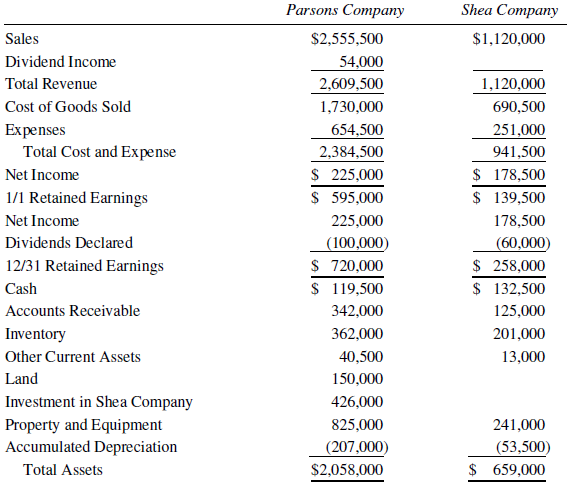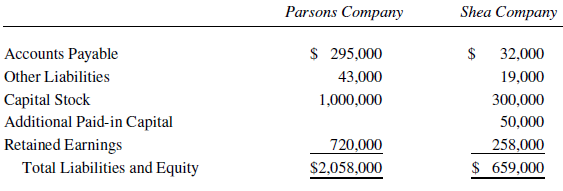Parsons Company acquired 90% of the outstanding common stock of Shea Company on June 30, 2019, for
Question:
Parsons Company acquired 90% of the outstanding common stock of Shea Company on June 30, 2019, for $426,000. On that date, Shea Company had retained earnings in the amount of $60,000, and the fair value of its recorded assets and liabilities was equal to their book value. The excess of implied over the fair value of the recorded net assets was attributed to an unrecorded manufacturing formula held by Shea Company, which had an expected remaining useful life of five years from June 30, 2019. Financial data for 2021 are presented here:


On December 31, 2019, Parsons Company sold equipment (with an original cost of $100,000 and accumulated depreciation of $50,000) to Shea Company for $97,500. This equipment has since been depreciated at an annual rate of 20% of the purchase price. During 2020 Shea Company sold land to Parsons Company at a profit of $15,000.
The inventory of Parsons Company on December 31, 2020, included goods purchased from Shea Company on which Shea Company recognized a profit of $7,500. During 2021, Shea Company sold goods to Parsons Company for $375,000, of which $60,000 was unpaid on December 31, 2021. The December 31, 2021, inventory of Parsons Company included goods acquired from Shea Company on which Shea Company recognized a profit of $10,500.
Required:
A. Prepare a consolidated financial statements workpaper for the year ended December 31, 2021.
B. Prepare a schedule to calculate consolidated retained earnings on December 31, 2021, using an analytical or t-account approach.
Financial StatementsFinancial statements are the standardized formats to present the financial information related to a business or an organization for its users. Financial statements contain the historical information as well as current period’s financial... Common Stock
Common stock is an equity component that represents the worth of stock owned by the shareholders of the company. The common stock represents the par value of the shares outstanding at a balance sheet date. Public companies can trade their stocks on...
Step by Step Answer:






